Topics
Category
Era
Morrison, George (1919–2000)
George Morrison with one of his paintings, 1998. From "Family photographs, 1940s, 1980s, 1998" in box 3 the George Morrison papers, Manuscripts Collection, Minnesota Historical Society, St. Paul.
George Morrison, one of Minnesota’s most important artists, is best known for his landscape paintings and wood collages. He drew inspiration from nature, combining impressionism with expressionism, cubism, and surrealism to develop a uniquely textured style. He referred to himself as a formalist in his approach to art.
Morrison’s artwork rarely includes overt references to his Ojibwe heritage. Therefore, he is not defined solely as an Native American artist. Resistant to being labeled, he described himself as a painter who happened to be Native. At the same time, Morrison’s prolific art often reflects a respectful connection to Ojibwe culture.
Born in 1919 in Chippewa City, outside the Grand Portage Indian Reservation, Morrison was one of twelve children in a close-knit family. He spoke only Anishinaabemowin until he was about six years old, when he learned English in school. Along with his brother Bernard, Morrison was eventually sent to Hayward Indian Boarding School in Wisconsin.
When he was ten, Morrison left Hayward and underwent surgery to treat tuberculosis of his left hip. To pass the time during his fourteen-month recovery in the hospital—including eight months with both legs in casts—Morrison took up reading, drawing, and carving.
Throughout his early education, Morrison’s teachers recognized and nurtured his extraordinary talents. His work led to a tribal scholarship to study commercial art at the Minneapolis School of Art (later the Minneapolis College of Art and Design). During Morrison’s time at college, from 1938 to 1943, he discovered that fine art held a greater appeal for him. Soon, he started developing an artistic sensibility as a modernist painter.
Upon graduating from the Minneapolis School of Art, Morrison received the prestigious Van Derlip Traveling Scholarship for the Art Students League (ASL) in New York, where he studied from 1943 to 1946. In New York, Morrison was regarded for his sophisticated tastes in art, literature, travel, culture, and jazz. He was fully immersed in the modern art community and his exhibits were well received by critics and artists alike.
In 1952, Morrison received a Fulbright scholarship. He continued his studies in Paris and Antibes, France. Upon finishing the Fulbright, Morrison received a fellowship from the John Hay Whitney Foundation. This afforded him the opportunity to work in Duluth, close to his family.
Morrison returned to New York in 1954 and became acquainted with influential American expressionists: Willem de Kooning, Jackson Pollack, and Franz Kline. Throughout the 1950s and 1960s, Morrison lived in cities in the Midwest and on the East Coast, including New York, Providence, and the Cape Cod art community of Provincetown. In Provincetown, Morrison gathered driftwood along the beaches to use in the creation of horizontal mosaic reliefs, which became highly sought after by collectors and galleries.
In 1960, he met his future wife, artist Hazel Belvo, at the Dayton Art Institute. Morrison and Belvo had one son together, Briand, and raised him with Belvo’s two other sons in artist communities. According to Belvo, the family was totally committed to art as a way of life.
Morrison taught art at various colleges, including Cornell, Dayton Art Institute, Rhode Island School of Design, and Pennsylvania State University. In 1970, he took a position at the University of Minnesota in Minneapolis, where he taught Native American studies and art.
In the mid-1970s, Morrison and his family built a home with an art studio on the Grand Portage Indian Reservation on Lake Superior, naming it Red Rock for the jasper in the nearby bluffs. This period marks a shift in Morrison’s art back to his Ojibwe roots and the nature surrounding him, as is seen in many of his horizon-line landscape paintings.
After Morrison retired from teaching in 1983, he moved permanently to Red Rock. There, he continued to work prolifically throughout the 1980s and 1990s, despite numerous health problems. He and Belvo divorced in 1993 but remained close.
By the early 1990s, Morrison was recognized as a founder of Native modernism. In 1999, he received a Master Artist Award from the Eiteljorg Museum Fellowship for Native American Fine Art.
Morrison continued to work at Red Rock until his death in April 2000, at the age of eighty.
Bibliography
Abbe, Mary. “Distinguished Artist George Morrison Dies.” Minneapolis Star Tribune, April 18, 2000.
——— . “Hymns to the Horizon: Art of George Morrison at History Center.” Minneapolis Star Tribune, February 19, 2015.
http://www.startribune.com/hymns-to-the-horizon-art-of-george-morrison-at-minnesota-history-center/292771901/
Casey, Chris. “A Bridge Between Two Cultures: Artist George Morrison Dead at 80.” Duluth News-Tribune, April 18, 2000.
“Grand Portage Proud of Chippewa Tribal Artist.” Minneapolis Star, February 12, 1954.
Lamke, Sherece. Art and Life of George Morrison: A “Beyond The Book” Special. DVD. St. Paul: Twin Cities Public Television, 2015.
Morrison, George, with Margot Fortunato Galt. Turning the Feather Around: My Life In Art. St. Paul: Minnesota Historical Society Press, 1998.
Rushing, W. Jackson III, and Kristin Makholm. Modern Spirit: The Art of George Morrison. Norman, OK: University of Oklahoma Press, 2013.
Related Resources
Primary
George Morrison: Reflections. Videocassette. Duluth, MN: WDSE-TV, 1998.
Morrison, George. George Morrison: Drawings. [Minneapolis: Walker Art Center, 1973].
——— . Standing in the Northern Lights: George Morrison, a Retrospective St. Paul: Minnesota Museum of Art, 1990.
Northern Lights: A Look At Minnesota Books and Writers (Northern Lights Minnesota author interview series). Episode 409, 1998.
https://collection.mndigital.org/catalog/p16022coll38:93
Secondary
Anthes, Bill. Native Moderns: American Indian Painting, 1940–1960. Durham, NC: Duke University Press, 2006.
Aurchuleta, Margaret, and Rennard Strickland. Shared Visions: Native American Painters and Sculptors in the Twentieth Century. New York: New Press for the Heard Museum, 1991.
Highwater, Jamake. The Sweet Grass Lives On: Fifty Contemporary North American Indian Artists. New York: Lippincott and Crowell, 1980.
Kostich, Dragos D. George Morrison: The Story of an American Indian. Minneapolis: Dillon Press, 1976.
Ordaz, Jason S. George Morrison: The Story of a Distinguished Anishinaabe Expressionist Painter; A Lecture By Gerad Vizenor. DVD. Sante Fe, NM: School of American Research, 2004.
Vizenor, Gerald Robert. “George Morrison: Anishinaabe Expressionist Artist.” American Indian Quarterly 30, no. 3/4 (summer/fall 2006): 646–660.
Web
Minnesota Museum of American Art. Modern Spirit, the Art of George Morrison; the Artist George Morrison.
http://mmaamorrison.org/pages/the-artist
Related Audio
MN90: The Genesis of Artist George Morrison
When George Morrison was ten, he was living away from his Chippewa (Ojibwe) community in Minnesota’s Arrowhead, convalescing in a children’s hospital and working on his art. That child became one of America’s great post-war abstract artists. MN90's Britt Aamodt reports.
All rights reserved
Articles
MN90: From Grand Marais to Paris
George Morrison had an art career that spanned several decades and two continents. He taught at the prestigious Rhode Island School of Design and studied abroad for several years. But he always came back to Minnesota’s North Shore. Producer Allison Herrera explores the world of one of Minnesota’ s most important artists.
All rights reserved
More Information
Articles
Related Images
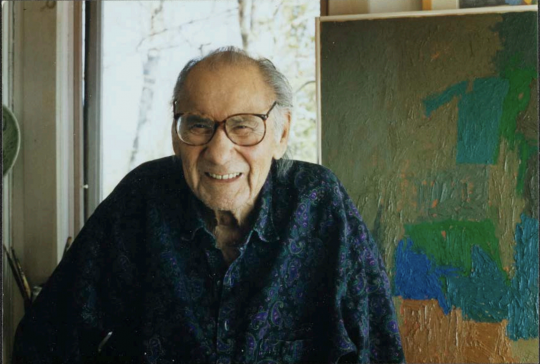
George Morrison with one of his paintings
George Morrison with one of his paintings, 1998. From "Family photographs, 1940s, 1980s, 1998" in box 3 the George Morrison papers, Manuscripts Collection, Minnesota Historical Society, St. Paul.
Holding Location
Articles
More Information
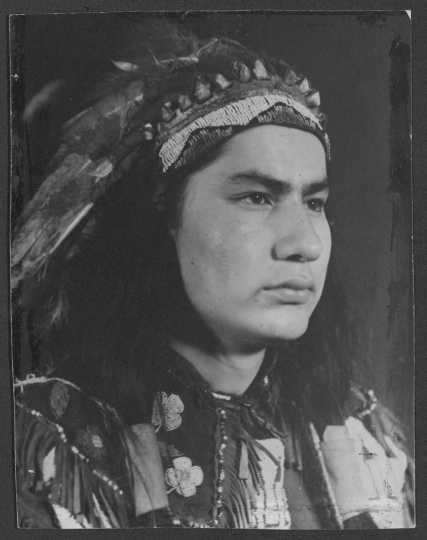
George Morrison wearing regalia
George Morrison wearing regalia, undated. From "Photographs: Childhood, family, Chippewa City, Grand Marais, professional, exhibits, 1905, 1920–1980s," in box 1 of the George Morrison papers, Manuscripts Collection, Minnesota Historical Society, St. Paul.
Holding Location
Articles
More Information
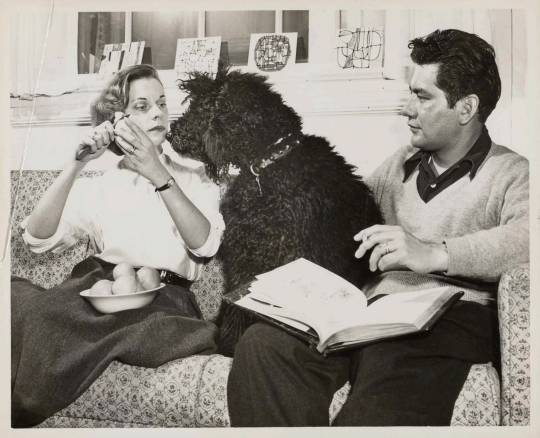
George Morrison with Ada Reed
George Morrison with Ada Reed, his first wife, ca. 1950s. From "Photographs, undated, 1950s, 1970s-1990s," in box 7 of the George Morrison papers, 1854–2005 (bulk 1948-2000), Manuscripts Collection, Minnesota Historical Society, St. Paul.
Holding Location
Articles
More Information

George Morrison and Hazel Belvo
Holding Location
More Information
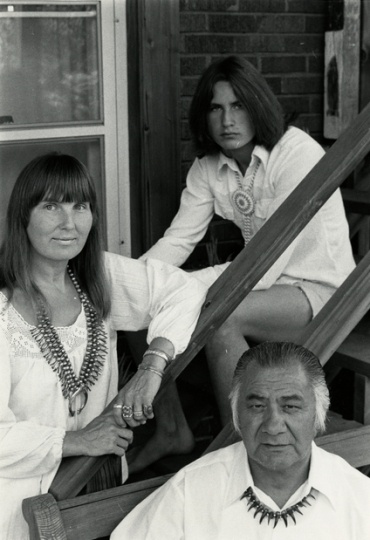
Hazel Belvo, George Morrison, and their son, Briand Morrison
Holding Location
Articles
More Information
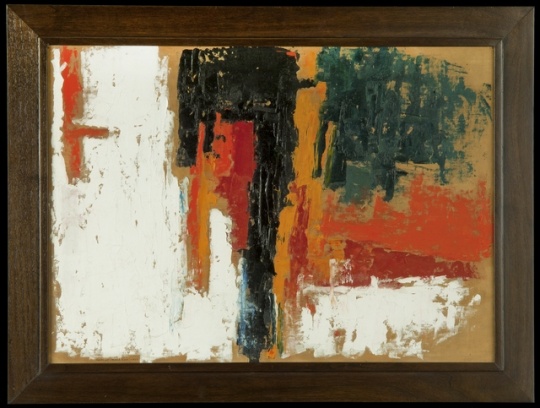
Untitled, an abstract oil raw canvasboard by George Morrison
Untitled, an abstract oil raw canvasboard,1959. Primarily orange, white, red, black and green in color. Painted by George Morrison.
Holding Location
Articles
More Information
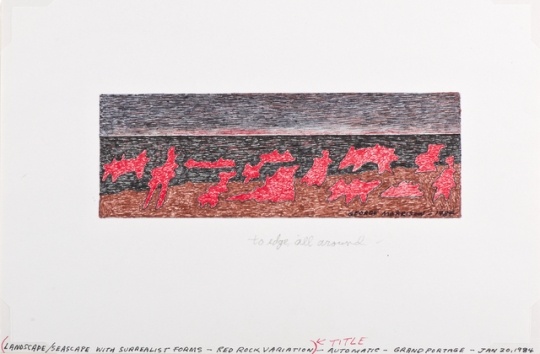
Landscape/Seascape with Surrealist Forms: Red Rock Variation
Landscape/Seascape with Surrealist Forms: Red Rock Variation, 1984. Drawn by George Morrison.
Holding Location
Articles
More Information
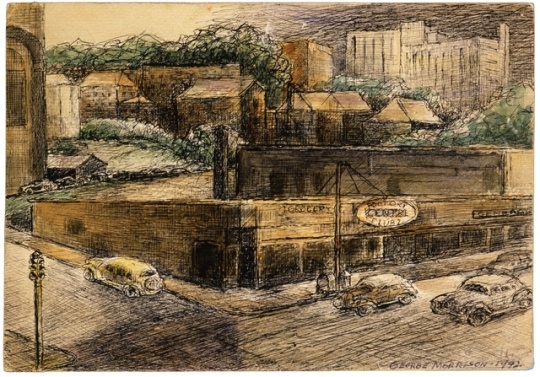
Duluth Corner, Drawing of St. Louis County
Holding Location
Articles
More Information

Dirt Track Specialist
Dirt Track Specialist oil painting, 1940. Painted by George Morrison.
Holding Location
Articles
More Information
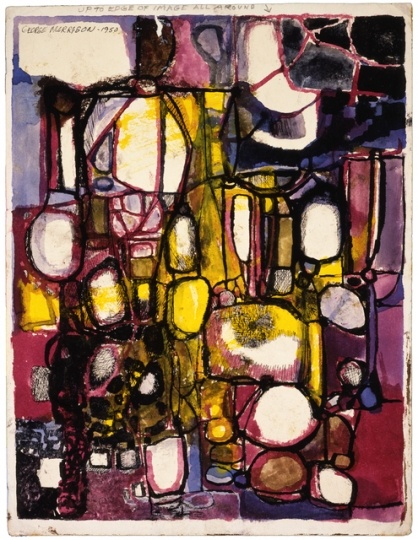
Abstract Composition watercolor painting
Abstract Composition watercolor painting, 1950. Painted by George Morrison.
Holding Location
Articles
More Information
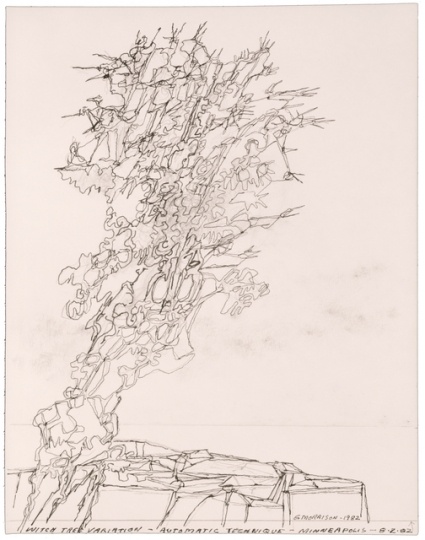
Witch Tree Variation drawing
Witch Tree Variation, 1982. Drawn by George Morrison.
Holding Location
Articles
More Information
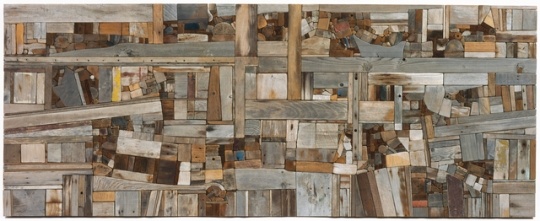
Untitled wood relief
Untitled wood relief, 1975. By George Morrison.
Holding Location
Articles
More Information
Related Articles
Turning Point
Morrison returns to Minnesota in the 1970s, builds a home on the Grand Portage Indian Reservation, and artistically reconnects with his Ojibwe roots.
Chronology
1919
1928
1930
1938
1943
1952
1953
1954
1960
1961
1963
1970
Mid-1970s
1983
1999
2000
Bibliography
Abbe, Mary. “Distinguished Artist George Morrison Dies.” Minneapolis Star Tribune, April 18, 2000.
——— . “Hymns to the Horizon: Art of George Morrison at History Center.” Minneapolis Star Tribune, February 19, 2015.
http://www.startribune.com/hymns-to-the-horizon-art-of-george-morrison-at-minnesota-history-center/292771901/
Casey, Chris. “A Bridge Between Two Cultures: Artist George Morrison Dead at 80.” Duluth News-Tribune, April 18, 2000.
“Grand Portage Proud of Chippewa Tribal Artist.” Minneapolis Star, February 12, 1954.
Lamke, Sherece. Art and Life of George Morrison: A “Beyond The Book” Special. DVD. St. Paul: Twin Cities Public Television, 2015.
Morrison, George, with Margot Fortunato Galt. Turning the Feather Around: My Life In Art. St. Paul: Minnesota Historical Society Press, 1998.
Rushing, W. Jackson III, and Kristin Makholm. Modern Spirit: The Art of George Morrison. Norman, OK: University of Oklahoma Press, 2013.
Related Resources
Primary
George Morrison: Reflections. Videocassette. Duluth, MN: WDSE-TV, 1998.
Morrison, George. George Morrison: Drawings. [Minneapolis: Walker Art Center, 1973].
——— . Standing in the Northern Lights: George Morrison, a Retrospective St. Paul: Minnesota Museum of Art, 1990.
Northern Lights: A Look At Minnesota Books and Writers (Northern Lights Minnesota author interview series). Episode 409, 1998.
https://collection.mndigital.org/catalog/p16022coll38:93
Secondary
Anthes, Bill. Native Moderns: American Indian Painting, 1940–1960. Durham, NC: Duke University Press, 2006.
Aurchuleta, Margaret, and Rennard Strickland. Shared Visions: Native American Painters and Sculptors in the Twentieth Century. New York: New Press for the Heard Museum, 1991.
Highwater, Jamake. The Sweet Grass Lives On: Fifty Contemporary North American Indian Artists. New York: Lippincott and Crowell, 1980.
Kostich, Dragos D. George Morrison: The Story of an American Indian. Minneapolis: Dillon Press, 1976.
Ordaz, Jason S. George Morrison: The Story of a Distinguished Anishinaabe Expressionist Painter; A Lecture By Gerad Vizenor. DVD. Sante Fe, NM: School of American Research, 2004.
Vizenor, Gerald Robert. “George Morrison: Anishinaabe Expressionist Artist.” American Indian Quarterly 30, no. 3/4 (summer/fall 2006): 646–660.
Web
Minnesota Museum of American Art. Modern Spirit, the Art of George Morrison; the Artist George Morrison.
http://mmaamorrison.org/pages/the-artist













